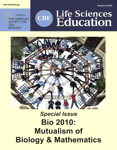Mathematics, Thermodynamics, and Modeling to Address Ten Common Misconceptions about Protein Structure, Folding, and Stability
Abstract
To fully understand the roles proteins play in cellular processes, students need to grasp complex ideas about protein structure, folding, and stability. Our current understanding of these topics is based on mathematical models and experimental data. However, protein structure, folding, and stability are often introduced as descriptive, qualitative phenomena in undergraduate classes. In the process of learning about these topics, students often form incorrect ideas. For example, by learning about protein folding in the context of protein synthesis, students may come to an incorrect conclusion that once synthesized on the ribosome, a protein spends its entire cellular life time in its fully folded native confirmation. This is clearly not true; proteins are dynamic structures that undergo both local fluctuations and global unfolding events. To prevent and address such misconceptions, basic concepts of protein science can be introduced in the context of simple mathematical models and hands-on explorations of publicly available data sets. Ten common misconceptions about proteins are presented, along with suggestions for using equations, models, sequence, structure, and thermodynamic data to help students gain a deeper understanding of basic concepts relating to protein structure, folding, and stability.



